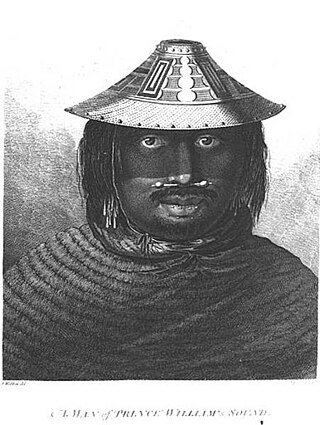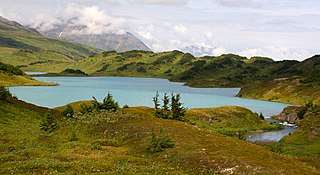Related Research Articles

The Exxon Valdez oil spill was a major environmental disaster that occurred in Alaska's Prince William Sound on March 24, 1989. The spill occurred when Exxon Valdez, an oil supertanker owned by Exxon Shipping Company, bound for Long Beach, California, struck Prince William Sound's Bligh Reef, 6 mi (9.7 km) west of Tatitlek, Alaska at 12:04 a.m. The tanker spilled more than 10 million US gallons (240,000 bbl) of crude oil over the next few days.

Valdez–Cordova Census Area was a census area located in the state of Alaska, United States. As of the 2010 census, the population was 9,636. It was part of the Unorganized Borough and therefore had no borough seat. On January 2, 2019, it was abolished and replaced by the Chugach Census Area and the Copper River Census Area.

Chenega is a census-designated place (CDP) on Evans Island in the Chugach Census Area in the U.S. state of Alaska. Located in Prince William Sound, the CDP consists of the Chugach Alutiiq village of Chenega Bay, which was established only after the Good Friday earthquake destroyed the original community on Chenega Island to the north. As of the 2020 census, the population of the CDP was 59, largely Alaska Natives; as of 2021, the population of Chenega is estimated at 49. Chenega Bay is in the Chugach School District and has one school, Chenega Bay Community School, serving approximately 16 students from preschool through high school.

Cordova is a city in Chugach Census Area, Alaska, United States. It lies near the mouth of the Copper River, at the head of Orca Inlet on the east side of Prince William Sound. The population was 2,609 at the 2020 census, up from 2,239 in 2010.

Tatitlek is a census-designated place (CDP) in Chugach Census Area, United States. The population was 88 at the 2010 census, down from 107 in 2000. Tatitlek is in the Chugach School District and has one school, Tatitlek Community School, serving about 15 students from preschool through high school. Tatitlek is served by the Tatitlek Airport.

Valdez is a city in the Chugach Census Area in the U.S. state of Alaska. According to the 2020 US Census, the population of the city is 3,985, up from 3,976 in 2010. It is the third most populated city in Alaska's Unorganized Borough.

Exxon Valdez was an oil tanker that gained notoriety after running aground in Prince William Sound, spilling her cargo of crude oil into the sea. On 24 March 1989, while owned by the former Exxon Shipping Company, captained by Joseph Hazelwood and First Mate James Kunkel, and bound for Long Beach, California, the vessel ran aground on the Bligh Reef, resulting in the second largest oil spill in United States history. The size of the spill is estimated to have been 40,900 to 120,000 m3. In 1989, the Exxon Valdez oil spill was listed as the 54th-largest spill in history.

Chugach, Chugach Sugpiaq or Chugachigmiut is the name of an Alaska Native people in the region of the Kenai Peninsula and Prince William Sound on the southern coast of Alaska. The Chugach people are an Alutiiq people who speak the Chugach dialect of the Alutiiq language.

The Alyeska consortium refers to the major oil companies that own and operate the Trans-Alaska Pipeline System (TAPS) through the Alyeska Pipeline Service Company.

Prince William Sound is a sound off the Gulf of Alaska on the south coast of the U.S. state of Alaska. It is located on the east side of the Kenai Peninsula. Its largest port is Valdez, at the southern terminus of the Trans-Alaska Pipeline System. Other settlements on the sound, which contains numerous small islands, include Cordova and Whittier plus the Alaska native villages of Chenega and Tatitlek.

Bligh Reef, sometimes known as Bligh Island Reef, is a reef off the coast of Bligh Island in Prince William Sound, Alaska. This was the location of the 1989 Exxon Valdez oil spill. After the incident, 33 US Code § 2733 mandated the operation of an automated navigation light to prevent future collisions with the reef. Despite these efforts the tug Pathfinder ran aground on Bligh Reef on Dec 24, 2009, rupturing its tanks and spilling diesel fuel. Bligh Reef is also where Alaska Steamship Company's Olympia ran aground in 1910.
Evans Island is an island in the Prince William Sound of southern Alaska. It lies just east of Bainbridge Island across the Prince of Wales Passage. Elrington Island lies to its south, Latouche Island to its southeast, and Knight Island to its northeast. Although Evans Island had been inhabited up to the time of the Russian exploration of Alaska, the island had no modern-day inhabitants until 1984, when a group of residents and former residents of the original Alutiq village of Chenega, on Chenega Island, decided to build the village of Chenega Bay on Crab Bay on Evans Island. Old Chenega had been destroyed and one-third of its residents had been killed by the tsunami from the 1964 Alaska earthquake. The new community of Chenega is coextensive with Evans Island, which has a land area of 74.605 km2 and a population of 86 persons as of the 2000 census.

The Chugach National Forest is a 6,908,540-acre (27,958 km2) United States National Forest in south central Alaska. Covering portions of Prince William Sound, the Kenai Peninsula and the Copper River Delta, it was formed in 1907 from part of a larger forest reserve. The Chugach includes extensive shorelines, glaciers, forests and rivers, much of which is untouched by roads or trails. It hosts numerous bird, mammal and marine species, including extensive shorebird habitat and a bald eagle population larger than the contiguous 48 states combined. Human industry in the forest includes extensive tourism and some mining and oil and gas operations.
Chenega Island is an island in Prince William Sound in the U.S. state of Alaska. It is the traditional home to the community of Chenega, though much of its population eventually migrated to Chenega Bay on nearby Evans Island after the 1964 Good Friday earthquake and accompanying tsunami. Chenega Island and its surrounding habitat were also heavily impacted by the 1989 Exxon Valdez oil spill. The island has a land area of 57.084 km2 and, after the mass emigration, was unpopulated as of the 2000 census.
Chugach Alaska Corporation, or CAC, is one of thirteen Alaska Native Regional Corporations created under the Alaska Native Claims Settlement Act of 1971 (ANCSA) in settlement of aboriginal land claims. Chugach Alaska Corporation was incorporated in Alaska on June 23, 1972. Headquartered in Anchorage, Alaska, Chugach Alaska Corporation is a for-profit corporation with over 2,200 Alaska Native shareholders primarily of Chugach Alutiiq, Eyak, and Tlingit descent.

Nancy Jane Ramey, later known by her married name Nancy Lethcoe, is an American former competition swimmer, 1956 Olympic medalist, and former world record-holder in two events.
Afognak Island State Park is a 75,047-acre (30,370 ha) Alaska state park on Afognak Island in Kodiak Island Borough, Alaska in the United States. Afognak Island is northeast of Kodiak Island on the Alaska Peninsula. Most of Afognak Island State Park is undeveloped. The park is known for its rugged topography and wide variety of wildlife. Afognak Island State Park is open to year-round recreation, including fishing, hunting, and hiking. Transportation is provided by float plane from Kodiak to various areas around the park. It is on the northern and eastern ends of the island and surrounds Perenosa, Seal and Tonki Bays. It borders part of Kodiak National Wildlife Refuge to the west.

Riki Ott is a marine toxicologist and activist in Cordova, Alaska. Ott was frequently introduced as an "oil spill expert" in her many media appearances during the height of the 2010 BP Deepwater Horizon oil spill news coverage. After graduating with a doctorate in sedimentary toxicology from the University of Washington, Ott moved to Alaska and started a fishing business. When the Exxon Valdez oil spill disrupted the local fishing-based economy, she became an environmental activist. Since the spill, she has participated in legal and public relations disputes with the Exxon company.
Bligh Island is an island located in Prince William Sound, Alaska. This island – or more precisely, the neighboring Bligh Reef – was the location of the 1989 Exxon Valdez oil spill.

Ellamar Mountain is a prominent 3,051-foot (930 m) mountain summit located in the Chugach Mountains, in the U.S. state of Alaska. It is situated 42 mi (68 km) northwest of Cordova, 18 mi (29 km) southwest of Valdez, and 3 mi (5 km) north of Tatitlek, on land managed by Chugach National Forest. It is approximately 9 mi (14 km) northeast of Bligh Reef, the location of the 1989 Exxon Valdez oil spill. The mountain's local name was taken from the copper mining camp of "Ellamar" at the southwest base of the mountain. In turn, Ellamar is a portmanteau of Ella and Margaret. When a post office was established for this new mining camp, C. L. Wayland, the first Postal Inspector for the Territory of Alaska and parts of the Pacific Northwest, coined Ellamar from the names of his wife, Ella, and daughter, Margaret. Precipitation runoff from the mountain drains into Prince William Sound.
References
- ↑ Knight Island: Block 1048, Census Tract 3, Valdez-Cordova Census Area, Alaska United States Census Bureau
- ↑ Chugach Visitor Guide - USDA Forest Service
- ↑ Galt, Jerry A., William J. Lehr, Debra L. Payton (1991). "Fate and transport of the Exxon Valdez oil spill. Part 4". Environmental Science and Technology. 25 (2): 202–209. doi:10.1021/es00014a001.
{{cite journal}}: CS1 maint: multiple names: authors list (link)
60°21′58″N147°44′22″W / 60.36611°N 147.73944°W